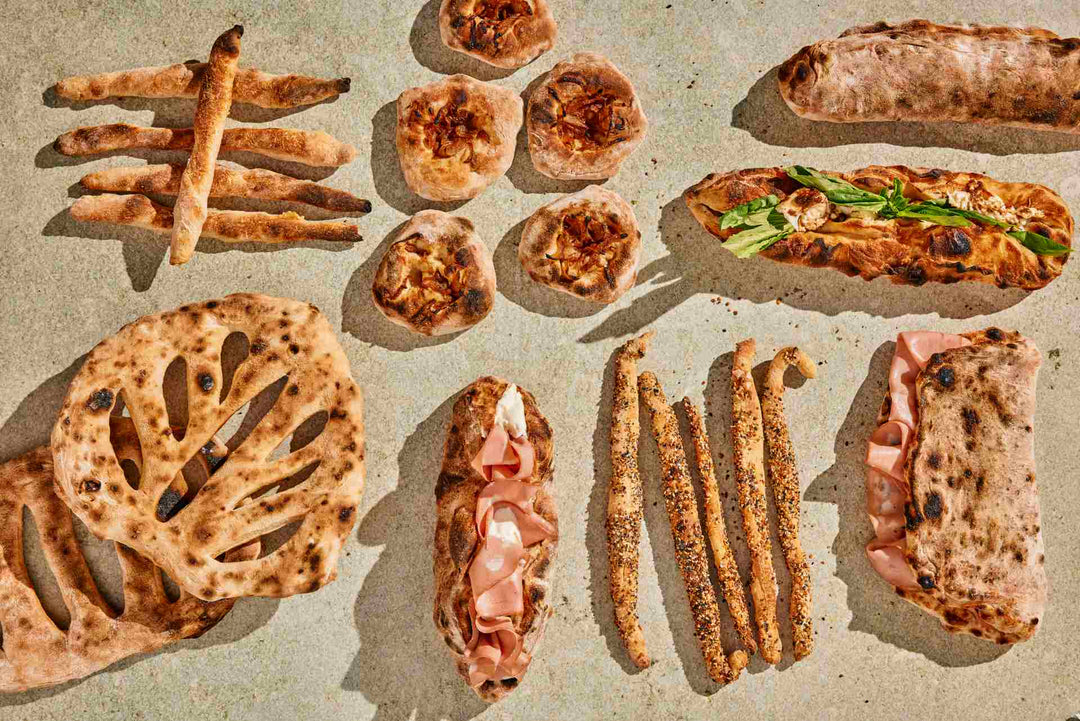t’s safe to say that Ooni Brand Partner, New Jersey native, chef and owner of Razza Pizza Artigianale Dan Richer loves delicious pizza. But he also enjoys using leftover dough in fun and creative ways, from crispy, oniony bialys to fluffy, fresh sandwich bread. And when it comes to dough, we trust Dan: in 2023, he was named Pizza Maker of the Year, and Razza was awarded the number two pizzeria in the country by 50TopPizza. Here, he shares four mouth-watering ideas for what to make if you have leftover dough and want to try something new.
1. Bialy
As someone who grew up in New Jersey, a state with a large Jewish population, Dan’s used to having bagels for breakfast. Bagels require a multi-step process, but bialys, a standard item at many East Coast bagel shops, are just as delicious and easier to make using leftover pizza dough. Originally from Bialystock (hence the name!), Poland, and brought to the U.S. by Eastern European Jews in the 1900s, the flattish roll with a depressed centre is usually topped with sautéed onions. They’re also thinner than a bagel, don’t require boiling before baking and stay fresher for longer.
To make bialys, you’ll start by cutting your 250-gram dough ball in half, then once more for a total of four pieces. After rounding the dough out with your fingers, create a little well in the middle, which can then be filled with sweet caramelised onions. (All you need is a few tablespoons (30 to 40 grams) of butter or oil in a non-stick skillet and two large onions finely peeled, seasoned, and sautéed on medium-low for 15 to 20 minutes, stirring occasionally).
Tip: Dan allows the dough to proof for about 10 minutes on a well-floured peel to let them relax and to give them a more open crumb before baking.
Pop the bialys into the oven, starting at 340 °C (650 °F) and then bring the temperature down to 290 °C (550 °F), baking for about one minute. Crispy on the outside and soft on the inside, these bialys are best eaten hot and fresh out of the oven!
2. Fougasse
Hailing from Provence, France, the fougasse loaf is made with herbs and olive oil and is sometimes compared to an Italian focaccia. With a crisp exterior and airy interior, fougasse are mini works of art formed into the shape of leaves or wheat stalks for a lovely table show-stopper. Dan prefers to bake his fougasse before he makes pizza to test the temperature of his oven and as a savoury, oh-so-shareable starter before the main event.
After stretching the leftover dough out into an oblong or oval shape, Dan uses a pizza slicer (a knife also works) to cut a slit down the middle and three on both sides for that signature leaf design. You can also make horizontal slits across the dough for the ladder look or make up your own design. For toppings, Dan likes to dip his fougasse in high-quality extra-virgin olive oil or brush on a mixture of melted garlic and anchovies before baking, but you can also add ingredients afterwards.
To cook, place the fougasse on a lightly floured pizza peel and launch the dough into an oven with a temperature of 370 °C (700 °F), then lower it to about 315 °C (600 °F) halfway through the bake.
Tip: Dan likes his bread extra crunchy and leaves it to bake for about two minutes, but if you want a softer dough, you can take it out after 90 seconds.
Once the fougasse are out of the oven, Dan suggests adding a herby salad on top, but you can also serve them with a comforting soup or spicy seafood stew. Ultimately, fougasse are made to tear into and eat with your hands, so grab some friends and get messy!
